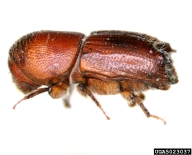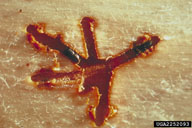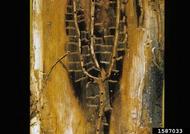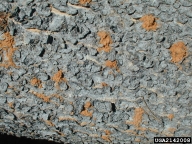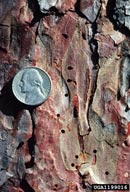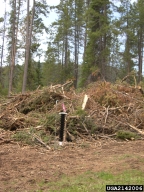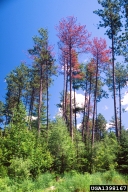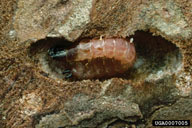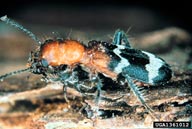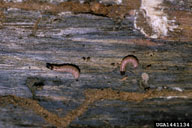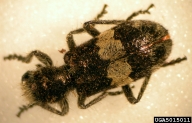Pine engraver beetle
Ips pini (Say) (Coleoptera: Curculionidae [formerly Scolytidae])
Orientation to pest
The pine engraver beetle, Ips pini (Say), is a native bark beetle with a very wide distribution in North America. In natural forests, this species is of little importance and is mainly associated with smaller diameter (12-20 cm) pine or spruce trees that are dying or have been recently killed by storms or logging. Under these conditions the species is beneficial and contributes to recycling of stressed or dying trees. Its numbers may increase when logging, thinning, or storms increase the amount of breeding material that is locally available. When this happens, healthy trees in the area may also be attacked. This species is considered the most important bark beetle attacking red pine (Pinus resinosa Sol. ex Aiton) in the Great Lakes states of the USA. Male beetles bore into trees and create a nuptial chamber. Each male produces pheromones that attract multiple females of the same species. After mating, 3 to 6 females constructoviposition galleries in the inner bark that radiate out from the nuptial chamber in a "Y" or "H" shaped pattern. Larval galleries branch off the oviposition galleries, and pupation takes place in cells at the end of the larval galleries. Pine engraver beetles can vector a blue stain fungus, which aids the beetle in killing the host tree by clogging the water-transporting elements in the tree. Symptoms and signs of pine engraver attack are essentially the same as those of many bark beetles, including yellow, red and-brown foliage of dying trees, together with boring dust and pitch tubes on the bark. Commonly, there are 3 to 4 generations of per year.
Hosts commonly attacked
Ips pini breeds in all the species of pines and spruce in its range and is of greatest concern in lodgepole (Pinus contorta Douglas), ponderosa (Pinus ponderosa Douglas ex C. Lawson), Jeffrey (Pinus jeffreyi Balf.) and red (Pinus resinosa) pines.
Distribution
The pine engraver is found from northern Canada and Alaska to northern Mexico. It occurs throughout most of the coniferous forests of North America except the Pacific Coastal forests, the southern pine forests, and Mexico. In the eastern United States, it is widespread in the north and extends along the Appalachian Mountains south to Georgia.
Images of pine engraver beetle
| Figure 1. Adult of pine engraver beetle, Ips pini | Figure 2. Nuptial chamber with five oviposition galleries branching off, with females in galleries at 2 and 10 o' clock | Figure 3. Larval galleries of the pine engraver projecting at right angles to the oviposition galleries | Figure 4. Frass ejected from bore holes by adult pine engravers |
| Figure 5. Adult emergence holes of pine engraver beetles | Figure 6. Lundgren funnel trap used to detect pine engraver beetles at a slash pile | Figure 7. Group of red pines (Pinus resinosa Soland.) in Minnesota killed by pine engraver beetle |
| Figure 8. Larva (left) and adult (right) of Thanasimus dubius, a common predator of the pine engraver beetle | Figure 9. Larva (left) and adult (right) of Enoclerus sphegeus, a common predator of the pine engraver beetle |
Important biological control agents related to this pest species
The natural enemies of the pine engraver beetle are similar to those of many bark beetles and include several predatory clerids, such as Thanasimus dubius (Fabricius) and Enoclerus sphegeus (Fabricius), as well as such parasitoids as the braconid Coeloides dendroctoni Cushman and the pteromalids Pachyceras xylophagorum Ratz., Rhopalicus pulchripennis (Crawford), and Tomicobia tibialis Ashmead.
Web links for information on pine engraver beetle
Articles
- Erbilgin, N., E. V. Nordheim, B. H. Aukema, and K. F. Raffa. 2002. Population dynamics of Ips pini and Ips grandicollis in red pine plantations in Wisconsin: within- and between-year associations with predators, competitors, and habitat quality. Environmental Entomology 31: 1043-1051.
- Dahlsten, D. L., D. L. Six, N. Erbilgin, K. F. Raffa, A. B. Lawson, and D. L. Rowney. 2003. Attraction of Ips pini (Coleoptera: Scolytidae) and its predators to various enantiomeric ratios of ipsdienol and lanierone in California: Implications for the augmentation and conservation of natural enemies. Environmental Entomology 32: 1115-1122 .
